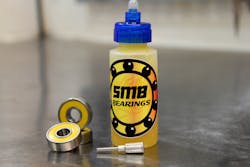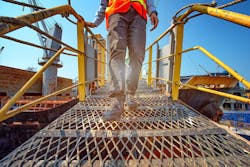The F1 in Schools competition sees students from around the world compete to design and race the fastest miniature car model. The UK took home the world champion title at the 2019 world finals in Abu Dhabi, but what can design engineers learn from this success? Here, Chris Johnson, managing director at specialist bearing supplier, SMB Bearings, explores the design options for ultra-low friction applications.
Frictional torque describes the force required to start and maintain the free running of a bearing. The effort needed to rotate a bearing depends greatly on the roundness of the bearing, the raceway geometry, the load applied, the lubrication and the closures. For most design engineers, friction is a friend and a foe. Useful friction enables predictable and steady movements at high loads, but non-useful friction is simply wasted energy, expelled in the form of heat.
For many applications, such as manufacturing measurement or dispensing instruments, very low bearing torque is vital. When sourcing ultra-low friction bearings for these high-value precision tools, there are multiple design considerations to keep friction to an absolute minimum.
Optimized raceway geometry and special sealing concepts go a long way in creating low-frictional torque levels. However, attention must also be paid to the production process, as any area of roughness on the raceway can diminish lubrication. The rings and balls of bearings should also be machined to fine tolerances and high levels of roundness to achieve smooth operating motion.
If not reduced or controlled effectively, a high amount of friction often leads to higher wear losses and ultimately, poor reliability and lifespan of the bearing. High torque bearings also increase the power required to drive the equipment, increasing the cost of moving the load and the energy required to operate the equipment.
A high-performance low torque lubricant is made or a break for ultra-low friction applications. Surprisingly, too much grease can be bad for a bearing, as a high grease fill means greater rolling resistance and a lack of free space inside the bearing to dissipate heat. Generally speaking, a lower fill is advised for high-speed, low torque applications.
For lower speeds, dry lubricants such as molybdenum disulfide can also reduce the friction between two surfaces without the need for oil or grease. For very low speeds or short-duration bursts of speed, unlubricated bearings may be used. If speeds are too high, low viscosity oils or greases with low viscosity base oils may be considered. Although greases have greater lubricant drag than oils or dry lubricants, a reduced fill can provide a low torque bearing while also being appropriate for high-speed applications.
There are many lubrication options to choose from and these are important considerations for design engineers embarking on new projects that require the sourcing and installation of new bearings. However, old machines shouldn’t be ignored. If bearings in existing machines are serviced or relubricated, it can significantly improve the operational and energy efficiency of the equipment for long-term cost savings.
Whether you’re designing components for an F1 model car or a real one, there are multiple factors to consider. Design engineers should adopt a holistic approach to bearing design, balancing the benefits and limitations of frictional torque to ensure optimum performance.
To increase bearing life and reduce energy costs, seek advice from a bearing specialist. For more information on SMB’s range of bearing options, or to discuss a specific ultra-low friction grease bearing application, visit smbbearings.com.
